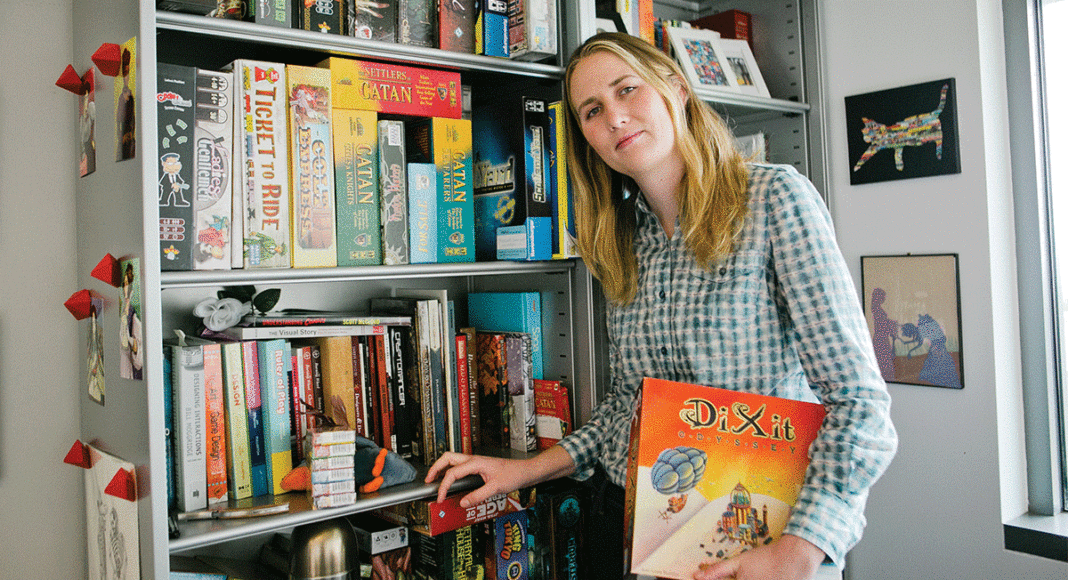Elizabeth Swensen is a willowy blonde with a degree in Classics, an alto singing voice and a sly smile. She’s also an IndieCade-award-winning game designer, designated an entrepreneur to watch in Forbes magazine’s “30 under 30” a few years back. Brand-new in her current gig as Assistant Professor of Art and Design at UCSC, Swensen’s games explore narrative structures—how the ability to change a game’s storyline affects the player’s emotional response. In other words, she’s interested in interactive gaming beyond the world of competitive violence.
“Oh, I love the violent video games too,” she chuckles. “I grew up with them.” But her current projects are distinctly educational and interactive. “I’m interested in creating a mix of physical and installation games,” she reveals, showing me images from a recent project on her computer. Board games, card sets, and books—including Alice in Wonderland—line one wall of her office overlooking UCSC’s music building and the ocean beyond. “I’m sort of a jack of all trades as far as games go,” Swensen admits. But she clearly favors physical games—they often begin as cards before they’re translated into more costly digital form—games that offer choices, that send the players to dictionaries, which in turn generate new role options.
“My underlying interest is self-expression, absolutely,” she says. “Absolutely” is a frequent Swensenism. “I define games as expressive art pieces that someone is engaged in with another participant.”
So games for her aren’t necessarily rule-governed. In Swensen’s game world, winning and losing might not be as important as emotional outcomes.
Growing up in Sonoma, Swensen played “a lot of video games. But we played outdoors too, and made up our own games. All children are game designers,” she believes, making up rules to make-believe games. After studying Classics at Willamette University—“I loved Latin poetry”—chance conversation with a colleague on a visit to Prague led to her consider video games seriously. She applied to the Interactive Media MFA program at USC. “I got accepted and just jumped at it,” she says.
Like most game designers, Swensen can program. “I can do basic scripting tasks, but my real expertise is in narrative and experience design,” she says. Her process can begin with a series of experiments and prototypes. Sometimes just simple shapes, figures, or cards out of paper. “Then we ask what the player can do in the game. We need a playable idea. We might practice a role-playing situation. Here we begin to get into the aesthetics of play. The games are competitive yet with an emotional outcome,” she explains.
Once the game has been tested, “you begin digitizing. That takes the most people—animators, artists, engineers. And depending upon the game, you might need a sound designer, or a composer, user interface design, character design.” And for all that you need graduate student assistants and money.
“In my work I’m targeting different expressive outcomes, not just violence. There’s already market saturation in that area,” she laughs. “The ecosystem of games is broad, but not as broad as it could be. I’m interested in how we can use games for social outcomes. I tend to make games for readers. Think visual novels that invite moral decisions, rather than games about racing and shooting.”
Her Master’s project was a celebrated iPad creation called “The Witch,” a role-playing game in which players take the role of a girl who has been labeled as a witch. Identity construction in an interactive context. Swensen’s interest in learning games led to “Application Crunch,” which helps introduce underserved middle school students to strategies for college planning. The cards offer opportunities, but they can also specify disasters. The player has to learn to make choices in order to juggle time and opportunities. Like life.
After five years as a researcher with the Game Innovation Lab at USC’s School of Cinematic Arts, Swensen left that dream job last year to come to UCSC, partly because the game design program was not in Engineering, but in the Arts. “That’s unusual,” she observes. “And I wanted to be surrounded by artists and expressive media, not just engineers.”
What’s next? “Well, ‘The Witch’ still haunts me. Right now I’m working on an update to that game,” she says, one that will expand the conversations she’s having about women’s involvement in the sciences and mathematics.
Swensen believes she’s good at her work “because I’m comfortable being a dabbler rather than an expert. I ask questions, I still love the Classics, and I engage in other forms of art, like music. And I love to cook—which is another kind of creative, expressive project,” says the willowy game designer. “I have no private life right now.”














